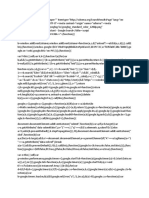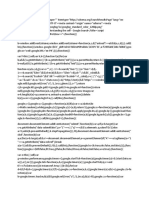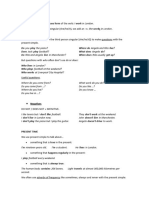Toxicology Urinalysis: Figure 1-1
Toxicology Urinalysis: Figure 1-1
Uploaded by
Christal Rae Tac-anCopyright:
Available Formats
Toxicology Urinalysis: Figure 1-1
Toxicology Urinalysis: Figure 1-1
Uploaded by
Christal Rae Tac-anOriginal Title
Copyright
Available Formats
Share this document
Did you find this document useful?
Is this content inappropriate?
Copyright:
Available Formats
Toxicology Urinalysis: Figure 1-1
Toxicology Urinalysis: Figure 1-1
Uploaded by
Christal Rae Tac-anCopyright:
Available Formats
CHAPTER 1 Laboratory Essentials
AdmiHospi tal
n istrator
BusiOffincesse
MediAdmicalsRecords
sions ClRadi
i n icoalloLab
gy Respi ratory
Pharmacy AdmiFaci
n i s ies ve Bil ing CodiAccounti
l ittrati &
ng ng
I maging Rehabil itation Support Human Resources
• Figure 1-1 Hospital organ izational chart.
Hematology Immunol
Serologyogy/ Microbiology Toxicology II Uri nalysis
• Figure 1-2 Clinical laboratory organizational chart .
immunology and serology, urinalysis, specimen collection, Hematology
and customer service. The individual laboratory sections are Hematology is the study of blood cells. Blood cells include
described later (Fig. 1 -2) . erythrocytes (i.e., red blood cells) , leukocytes (i.e., white
blood cells) , and thrombocytes (i.e., platelets) . The most
Departments and Their Functions common test performed in this department is the com
Clinical Chemistry plete blood count (CBC) , which is a summary of cell
Clinical chemistry is the medical discipline that uses various counts (i.e., red, white, and platelet) , total hemoglobin
methods of analysis and instrumentation to determine val level, red blood cell size, and hematocrit. A CBC usually
ues for chemical components in normal and diseased states, includes a differential count, which reports the percentage
types and concentrations of blood toxins, and therapeutic of each type of white blood cell in the blood sample. Cell
drug levels. Routine tests run by the clinical chemistry section counts for body fluids are also performed in this depart
analyze levels of glucose, blood urea nitrogen (BUN), electro ment. Other tests include reticulocyte counts and erythro
lytes, calcium, phosphorus, magnesium, lipids, liver function cyte sedimentation rates.
values, alkaline phosphatase, creatinine kinase, creatinine, In many laboratories, coagulation testing is performed
protein, albumin, and hemoglobin A1c. The clinical chem in the hematology department. Routine coagulation tests
istry department also runs hepatitis panels, tests for rubella include the prothrombin time (PT) and the activated par
and human immunodeficiency virus (HIV) , and determines tial thromboplastin time (aPTT) . These tests assess the two
levels of antibodies in the blood. Hormone levels (e.g., thy major clotting pathways in the body.
roid-stimulating hormone, prolactin, follicle-stimulating
hormone) are tested in another section of this laboratory. Microbiology
The routine tests are usually run in the main clinical The microbiology department identifies microorgan
chemistry department. The antibody and hormone levels isms that cause disease and determine the most effective
are usually considered subspecialties. Other subspecialty antibiotic to destroy bacterial pathogens. This department
departments include the toxicology, therapeutic drug mon grows cultures from major body systems such as the throat,
itoring, molecular diagnostics, and fecal analysis. Some urine, stool, wound, blood, eyes, ears, body fluids, nasal,
clinical chemistry laboratories have a section that analyzes abscesses, vagina, urethra, and tissues. Surgeons often per
blood gases. form a culture after they drain or debride an infected area.
You might also like
- Planetary Aspects in KPDocument4 pagesPlanetary Aspects in KPKrishna CHNo ratings yet
- Service CapabilityDocument2 pagesService CapabilityDIVINE LABNo ratings yet
- Clinical LaboratoryDocument7 pagesClinical Laboratoryjocelyn reyesNo ratings yet
- PMLS Sections of Clinical LaboratoryDocument6 pagesPMLS Sections of Clinical LaboratoryNicole Anne De VillaNo ratings yet
- Untitled DocumentDocument3 pagesUntitled DocumentFharhaina JulkipliNo ratings yet
- Clinical LaboratoryDocument40 pagesClinical Laboratoryy4jjvbqr9kNo ratings yet
- PMLSDocument3 pagesPMLSKate Angilene CarreraNo ratings yet
- 1.introduction About The Study A) Feasibility StudyDocument19 pages1.introduction About The Study A) Feasibility StudyDiscov Singh100% (8)
- Activity 17 Clinical ChemistryDocument53 pagesActivity 17 Clinical ChemistryKendrix Aguiluz Florendo100% (1)
- Quick guide to Laboratory Medicine: a student's overviewFrom EverandQuick guide to Laboratory Medicine: a student's overviewNo ratings yet
- Clinical Laboratory Science Is Crucial To The Practice of Modern Medicine. Data From Clinical Laboratories Is Used byDocument48 pagesClinical Laboratory Science Is Crucial To The Practice of Modern Medicine. Data From Clinical Laboratories Is Used bykimmy0410_0512No ratings yet
- Medical Laboratory - WikipediaDocument9 pagesMedical Laboratory - WikipediaTYAS PAMILUNINGSIHNo ratings yet
- Jurnal BaruDocument6 pagesJurnal Baruirsan butonNo ratings yet
- Laboratory Activity No 1Document5 pagesLaboratory Activity No 1leexxjannelapatNo ratings yet
- Testing in The Clinical LabDocument3 pagesTesting in The Clinical LabRabindra P.SinghNo ratings yet
- PathologyDocument7 pagesPathologylifebeat1436No ratings yet
- Pathology 3marksDocument11 pagesPathology 3markslifebeat1436No ratings yet
- Mod 1Document26 pagesMod 1SEAN MELNOR LOSBAÑESNo ratings yet
- Clinical Lab and Intro To PhleboDocument45 pagesClinical Lab and Intro To PhleboKeren Nathaniel AlvaradoNo ratings yet
- CHAPTER-17 NUERO MergedDocument17 pagesCHAPTER-17 NUERO MergedRyn ShadowNo ratings yet
- 9780702072987-Book ChapterDocument2 pages9780702072987-Book ChaptervisiniNo ratings yet
- Labman Group Project.1Document20 pagesLabman Group Project.1mczarinalouisseangelaNo ratings yet
- Diagnostic TestingDocument112 pagesDiagnostic TestingAbdullah AbsaniNo ratings yet
- مادة امتحان النصفي - mergedDocument250 pagesمادة امتحان النصفي - mergedyousefjarrar606No ratings yet
- Case Pre Labs 4th FloorDocument5 pagesCase Pre Labs 4th FloorLorraine Nicolne B. CortejoNo ratings yet
- 1 Chapter One New IntroductionDocument63 pages1 Chapter One New IntroductioneltorhemaNo ratings yet
- CM Intro Laboratory Equipment PPDocument21 pagesCM Intro Laboratory Equipment PPGeronimoNo ratings yet
- 2JelaluK - Laboratory Manual and Review On Clinical Pathology PDFDocument33 pages2JelaluK - Laboratory Manual and Review On Clinical Pathology PDFOUR STORYNo ratings yet
- Laboratory Manual and Review On Clinical Pathology PDFDocument32 pagesLaboratory Manual and Review On Clinical Pathology PDFanggaririnNo ratings yet
- Ali HamzaDocument14 pagesAli Hamzaalikof11156No ratings yet
- Lesson 8 Special Collections and Point-of-Care Testing: Principles of Medical Laboratory Science 2Document19 pagesLesson 8 Special Collections and Point-of-Care Testing: Principles of Medical Laboratory Science 2nwgcyrb8v9No ratings yet
- Pmlsp1 - Routine Lab TestsDocument3 pagesPmlsp1 - Routine Lab TestsJm AshiiNo ratings yet
- Clinical BiochemistryDocument25 pagesClinical Biochemistrymirzafahad82005100% (1)
- Tertiary Laboratory Site Visit FinalDocument8 pagesTertiary Laboratory Site Visit FinalSebNo ratings yet
- Finals Notes (PMLS-1)Document5 pagesFinals Notes (PMLS-1)Una Kaya CabatinganNo ratings yet
- Lesson 11 Unit VII Text Related To Clinical AnalysisDocument4 pagesLesson 11 Unit VII Text Related To Clinical AnalysisSádia MatateNo ratings yet
- Return LabelDocument3 pagesReturn LabelJerica Basco LayosNo ratings yet
- Syllabus For Written Examination For Selection To The Post of Laboratory Technician.Document2 pagesSyllabus For Written Examination For Selection To The Post of Laboratory Technician.143bhaumikNo ratings yet
- VLD411 SyllabusDocument1 pageVLD411 SyllabusransinghNo ratings yet
- اسئله شائعة ف مقابله المختبر 3 pdfDocument6 pagesاسئله شائعة ف مقابله المختبر 3 pdfAnas ShwbkNo ratings yet
- European Journal of Biomedical AND Pharmaceutical SciencesDocument5 pagesEuropean Journal of Biomedical AND Pharmaceutical SciencesGaurav AggarwalNo ratings yet
- Leucocytes and CD4 Counts of Petrol Attendants in Ekpoma Edo State NigeriaDocument8 pagesLeucocytes and CD4 Counts of Petrol Attendants in Ekpoma Edo State NigeriaAthenaeum Scientific PublishersNo ratings yet
- HBII Lab Manual 14-1-2019Document50 pagesHBII Lab Manual 14-1-2019Ahmed Khaled Abo EldahabNo ratings yet
- Dongzal-MLS - Classification of LabDocument2 pagesDongzal-MLS - Classification of LabShin DongzalNo ratings yet
- Lib Study Point 2Document23 pagesLib Study Point 2Tanya SinghNo ratings yet
- HaematologyDocument11 pagesHaematologyjess waldenNo ratings yet
- LMGT Trans 1Document1 pageLMGT Trans 1Christian L. TolentinoNo ratings yet
- 2020-Biochem-Activity-17 Clinical ChemDocument24 pages2020-Biochem-Activity-17 Clinical ChemGabrielle John HernaezNo ratings yet
- CLM Lec 6Document21 pagesCLM Lec 6m dawoodNo ratings yet
- كورس اللابDocument110 pagesكورس اللابgaber 230No ratings yet
- Functions of Clinical LaboratoryDocument5 pagesFunctions of Clinical Laboratoryclaireannroguel23No ratings yet
- 2021 Biochem Activity 17 Clinical ChemistryDocument25 pages2021 Biochem Activity 17 Clinical ChemistryRaymark Flores EllamilNo ratings yet
- 2023 Biochem Activity 17 Clinical ChemistryDocument25 pages2023 Biochem Activity 17 Clinical ChemistryCharlene AlmazanNo ratings yet
- Syllabus JR MLT 2023Document5 pagesSyllabus JR MLT 2023SUSHANT SAHOONo ratings yet
- SAS CC1 Session 1 Scope of Clinical ChemistryDocument9 pagesSAS CC1 Session 1 Scope of Clinical ChemistryRuchieNo ratings yet
- Lmy 030Document7 pagesLmy 030Tuan NguyenNo ratings yet
- LaboratoryDocument49 pagesLaboratorybonat0750% (2)
- Chapter 6 Diagnostic TestsDocument8 pagesChapter 6 Diagnostic TestsMaria VictoriaNo ratings yet
- LMGTDocument65 pagesLMGTApril CabatuandoNo ratings yet
- Chem Lec - PrelimsDocument19 pagesChem Lec - Prelimscherrycayari13No ratings yet
- Non-Imaging Nuclear Medicine Methods (A Review Study) : Conference PaperDocument5 pagesNon-Imaging Nuclear Medicine Methods (A Review Study) : Conference PaperNajah Dhuha AfifahNo ratings yet
- 07 Following DoctypeDocument252 pages07 Following DoctypeChristal Rae Tac-anNo ratings yet
- 09 Can DoctypeDocument162 pages09 Can DoctypeChristal Rae Tac-an100% (1)
- 06 Assistant DoctypeDocument166 pages06 Assistant DoctypeChristal Rae Tac-anNo ratings yet
- 05 Ninja DoctypeDocument179 pages05 Ninja DoctypeChristal Rae Tac-anNo ratings yet
- 01 Rude DoctypeDocument215 pages01 Rude DoctypeChristal Rae Tac-anNo ratings yet
- 04 Betrayed DoctypeDocument178 pages04 Betrayed DoctypeChristal Rae Tac-anNo ratings yet
- Adelaide DoctypeDocument219 pagesAdelaide DoctypeChristal Rae Tac-anNo ratings yet
- Understanding The Self DoctypeDocument131 pagesUnderstanding The Self DoctypeChristal Rae Tac-anNo ratings yet
- Airforce DoctypeDocument154 pagesAirforce DoctypeChristal Rae Tac-anNo ratings yet
- Vaporizer Isoflurane DoctypeDocument131 pagesVaporizer Isoflurane DoctypeChristal Rae Tac-anNo ratings yet
- Generic Documents DoctypeDocument115 pagesGeneric Documents DoctypeChristal Rae Tac-anNo ratings yet
- Organizational Structure: I N Patient La BoratoriesDocument1 pageOrganizational Structure: I N Patient La BoratoriesChristal Rae Tac-anNo ratings yet
- Present SimpleDocument3 pagesPresent SimpleclarasemitielbNo ratings yet
- C Notes For ProfessionalsDocument340 pagesC Notes For ProfessionalsPeter Ranieri100% (1)
- MplsDocument124 pagesMplsmgitecetechNo ratings yet
- w93c26 PDF EngDocument20 pagesw93c26 PDF EngParalela 91 DigitalNo ratings yet
- Manual On Air Traffic Safety Electronics Personnel Competency-Based Training and AssessmentDocument214 pagesManual On Air Traffic Safety Electronics Personnel Competency-Based Training and Assessmentiosha0No ratings yet
- Investor ReportDocument36 pagesInvestor ReportAlexandre CauetNo ratings yet
- Everything You Need To Know About The Conjugation of "Essere" in ItalianDocument1 pageEverything You Need To Know About The Conjugation of "Essere" in ItalianTatjana MilosavljevicNo ratings yet
- Energy Testing YourselfDocument30 pagesEnergy Testing Yourselfsale18100% (7)
- 2010 UMass Lowell GraduatesDocument10 pages2010 UMass Lowell GraduatesNoahBombardNo ratings yet
- Mint Coin ChangeDocument234 pagesMint Coin ChangeNick Taylor-VaiseyNo ratings yet
- Jaiswal 2015Document18 pagesJaiswal 2015MalikNo ratings yet
- Jurnal Case Control 1Document7 pagesJurnal Case Control 1Linda MarcelaNo ratings yet
- Sekolah Menengah Kebangsaan Sungai Layar, 08000 SG Petani, KedahDocument4 pagesSekolah Menengah Kebangsaan Sungai Layar, 08000 SG Petani, KedahAsoda VaNo ratings yet
- Ldla CV 01-13-19Document7 pagesLdla CV 01-13-19api-284788195No ratings yet
- Examen Sansa A DouaDocument14 pagesExamen Sansa A Douaelenapet1No ratings yet
- 7 Innovation Habits 231117 R1Document2 pages7 Innovation Habits 231117 R1Prashant Yeshwant JoglekarNo ratings yet
- Epic PoemDocument6 pagesEpic Poemapi-241206778No ratings yet
- Lesson Plan M5Document34 pagesLesson Plan M5Rhea CadungoNo ratings yet
- BUS 1101 Learning Journal Unit 1 2020Document2 pagesBUS 1101 Learning Journal Unit 1 2020joel konse50% (2)
- G8 U1 Inv 2 ACE AnswersDocument7 pagesG8 U1 Inv 2 ACE AnswersyolooNo ratings yet
- Scriptures For Studying and ExamsDocument3 pagesScriptures For Studying and Examsvimon100% (1)
- AAIR BOA - Complete File - November 23Document54 pagesAAIR BOA - Complete File - November 23Rex LimNo ratings yet
- Review of Research: A Study On Pestle Analysis of Banking Industry With A Special Reference To HDFC BankDocument6 pagesReview of Research: A Study On Pestle Analysis of Banking Industry With A Special Reference To HDFC BankSAMIR GAMITNo ratings yet
- Lottery Business Plan TemplateDocument5 pagesLottery Business Plan Templatehirnsubie100% (1)
- The Population BombDocument140 pagesThe Population BombHsien LouNo ratings yet
- Cesarean DeliveryDocument210 pagesCesarean DeliveryJosé Ramírez100% (3)
- Growth: StrategiesDocument28 pagesGrowth: StrategiesJelna CeladaNo ratings yet
- Sample Question Paper: General Knowledge and Current AffairsDocument4 pagesSample Question Paper: General Knowledge and Current Affairsshano chaudharyNo ratings yet
- A Complete History of Pakistan Before and After PartitioDocument15 pagesA Complete History of Pakistan Before and After PartitioMuhammad AslamNo ratings yet





































































































